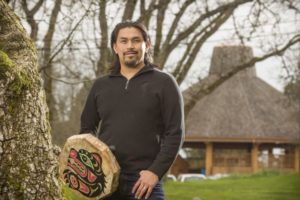It’s always challenging and exciting to take on a big project. Sometimes it can be downright intimidating. But for Coast Salish carver Bear Horne, carving an 18-foot totem pole on the grounds of Camosun College’s Interurban campus just feels like the next, natural step in his personal journey.
“I’ve pretty much been carving my entire life,” says Horne, who is currently carving the totem for the college’s Centre for Trades Education and Innovation building. “I grew up watching my dad carve; I used to walk around and pick up tools, blocks of wood, sometimes walk on top of the logs… It has been a lifelong road for me.”
Horne remembers sitting in his father’s shop and watching him work, experiences that had great impact on him.
“He used to work… sort of regular hours?” Horne laughs. “He would really make his own hours, but whenever he was down there, I would want to spend my time with him. I would watch him carve for hours at a time. I would just be with him. I remember picking up whatever he was working on at the time, looking at how it was different than the last time that I picked it up.”
Horne doesn’t usually work alone, though. He says that he has a whole family who carves.
“There is always someone there; there is always someone who helps out,” he says. “I have a whole family who carve. All my uncles carve, some of my cousins carve; at least one of them will come, often three or four, whoever wants to help out. But on this specific project, it’s just me working on it, because it’s not a traditional totem pole.”

Horne was a student at Camosun when the idea of the totem came to him.
“I took the Indigenous Studies program, and while I was a student, I created a couple of sculptures for the college,” he says. “I created the podium for the graduation ceremony, as well a memorial bench for Naut’sa mawt. Around then, I became friends with [Camosun vice president of education] John Boraas. He had an idea, and had put out a call to local artists… And then I had an idea for what I envisioned for the spot where they wanted to put the piece. I put in a submission around the ideas that I had, around some of the things that I had experienced, some of the feelings that I took with me from being a student at Camosun.”
Horne says these feelings are represented in the characters on the totem itself.
“It is really around my own experiences at Camosun,” says Horne. “The heron is the largest piece that is going to be in the installation. The heron is a representation of patience and perseverance—the time that it takes to change your goals while you’re going to school at Camosun.”
Horne says that the totem pole is also a representation of the instructors, and the patience and the guidance that they have learned there that they share with Camosun students.
“On the top part of the installation, there’s a sun design,” he says. “That is a representation of the strength and the energy of the good feelings that come from completing something and from the relationships that you make in school, and the energy they bring. The last piece, on the bottom, is a salmon. They represent how the salmon leaves the river, and goes out in the ocean… then comes back up the river. So that is like the renewal, the things you learn while you are in school, then you bring those out with you while you are living your life, and some of the students will come back to be instructors at the school they went to. It is all part of the renewal, part of the return of the gifts that you received, brought back with you.”
